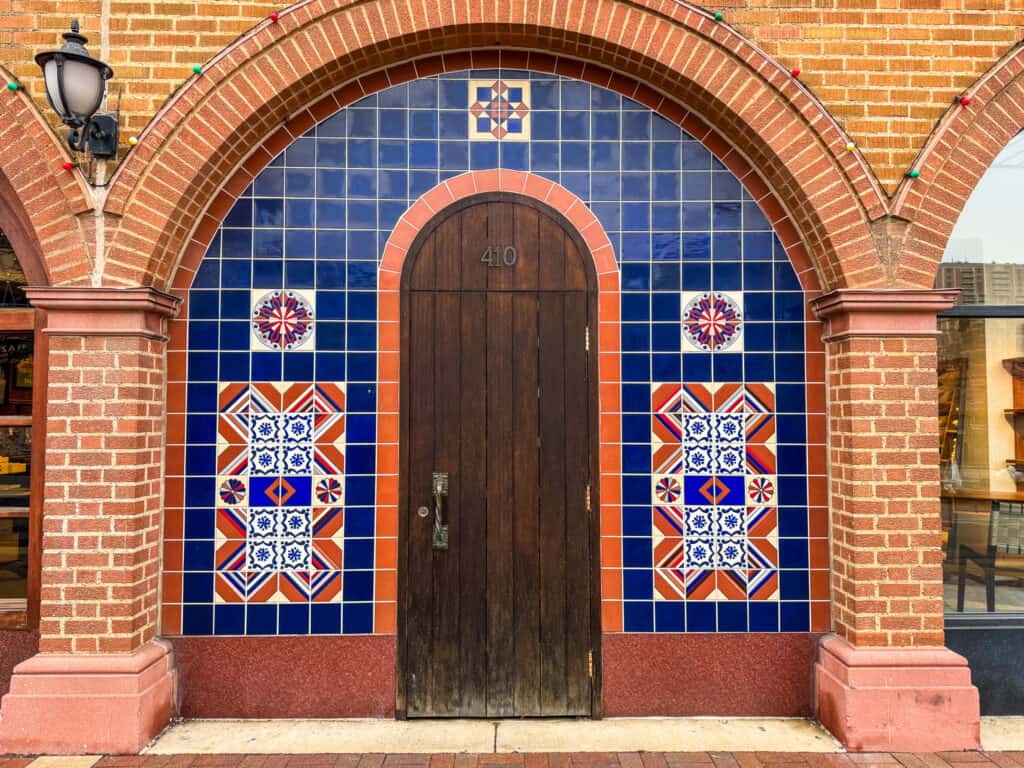
The Country Club Plaza, situated in midtown Kansas City, stands as a significant landmark in urban design and commercial development.
Established in 1923, the Plaza was the first shopping center in the United States specifically designed to accommodate automobiles, marking a notable departure from the traditional downtown retail environments of that era.
During the early 20th century, the typical American shopping experience revolved around downtown areas, where department stores offered a range of modern and fashionable merchandise.
However, local developer J.C. Nichols conceived a revolutionary approach with the Country Club Plaza.
Unlike the congested and sometimes grimy downtown districts, the Plaza provided a suburban alternative that catered to the needs of both high-rise apartment dwellers and nearby neighborhood residents.
Nichols envisioned the Plaza as a mixed-use development, blending everyday shopping convenience with the allure of unique retail experiences.
This concept not only showcased innovation for its time but also represented a shift in American urban planning and retail strategy.
The Plaza’s design, with its emphasis on accommodating cars, anticipated the increasing importance of automobiles in American life, setting a precedent for future developments nationwide.
Today, the Country Club Plaza remains a vital and cherished part of the Kansas City community, attracting millions of visitors annually and serving as a symbol of early 20th-century innovation in urban and retail planning.
The excellent hotel options make it convenient for visitors to truly immerse themselves in the culture and history of The Plaza.
In this article, we share the history of Kansas City’s Country Club Plaza from it’s beginnings to today.
Make the most of your visit to the historic Country Club Plaza! Read our guide to shopping on The Plaza – we highlight the best local shops and list all the options by category.
The Visionary Beginnings
The origins of Kansas City’s Country Club Plaza can be traced back to the early 1900s, a time characterized by the visionary planning of J.C. Nichols.
Nichols embarked on a transformative journey, shaping a significant portion of Kansas City into what he referred to as the Country Club District.
Early Neighborhood Development
Nichols’ approach to urban development was comprehensive and meticulous.
The neighborhoods south of Brush Creek were designed with attention to detail evident in their scenic streets, extensive landscaping, and decorative elements such as fountains and statues. This created a harmonious and visually pleasing environment.
However, these neighborhoods were not just aesthetically appealing; they were also highly functional, incorporating amenities like neighborhood schools, parks, and integrated public transportation.
This exemplified Nichols’ philosophy of “planning for permanence” – an approach that extended beyond the construction of houses and aimed at creating vibrant communities.
In 1905, Nichols began this endeavor with a 10-acre tract at 51st and Grand, and within four years, his company was overseeing the development of 1,000 acres.
This project was part of a broader movement that complemented and enhanced the Park and Boulevard System, Ward Parkway being one of them, which was developed by the Kansas City Board of Park Commissioners since the early 1900s.
The Master Plan
As the world emerged from the aftermath of World War I, Nichols’ vision expanded.
In the 1920s, the construction of the Country Club Plaza on the north side of Brush Creek commenced, signifying a significant leap in retail-oriented development.
Nichols’ principle of “planning for permanence” was clearly evident in the Plaza’s design.
It wasn’t just a shopping center; it was a comprehensive urban development that catered to the everyday needs of the community while offering unique shopping experiences.
The Plaza’s development was meticulously strategic, with thoughtfully positioned groupings of commercial buildings inspired by European village centers, resulting in a harmonious blend of functionality and charm.
The Plaza’s strategic location played a pivotal role in its success.
In the mid-1920s, the Federal Highways Act of 1926 established a national road system. Nichols astutely ensured that U.S. 50-S (now U.S. 56) would pass directly through the Plaza, positioning it as a primary entry point for automobiles into the city.
This masterstroke by Nichols placed the shopping destination in the path of significant traffic flow, essentially revolutionizing the concept of suburban shopping and embracing the flourishing era of the automobile.
The Plaza welcomed its first shops in 1923, marking the commencement of a new chapter in both Kansas City’s and America’s retail history.
“Nichols’ Folly” to National Fame
The initial concept of the Country Club Plaza was met with considerable skepticism, earning the moniker “Nichols’ Folly” from local media.
Early Skepticism for Nichols’ Vision
The skepticism surrounding the Country Club Plaza arose from doubts regarding the feasibility and practicality of J.C. Nichols’ groundbreaking concept.
However, Nichols was a visionary ahead of his time, foreseeing the automobile not as a luxury reserved for the privileged few, but as a fundamental aspect of future urban life.
His foresight and unwavering determination swiftly transformed skepticism into admiration as the Plaza emerged as an exemplar of visionary success.
Serving as the inaugural shopping district in the United States designed specifically to accommodate automobile patrons, the Country Club Plaza marked a significant departure from the conventional downtown-centric retail environment.
The Plaza’s design transcended mere functionality, boasting an aesthetically pleasing Spanish Revival architectural theme.
Exquisite bell towers, ornamental ironwork, facades adorned with brick and stucco, vibrant ceramic tile mosaics, and clay tile roofs, inspired by the splendor of Seville, Spain, added to its inherent charm and allure.
The Automobile Era
The Plaza’s design incorporated a crucial element: accommodating the automobile, a relatively new phenomenon in the 1920s. Nichols recognized the impact of cars on urban landscapes and consumer behavior.
To embrace this emerging trend, the Plaza featured eight filling stations in its early years. Furthermore, it offered ample free parking, seamlessly blending it into the overall design to preserve the Plaza’s aesthetic appeal.
This pioneering fusion of automobile accessibility and architectural beauty set the stage for future urban developments throughout America.
The Plaza’s success can be attributed to its ability to harmoniously blend functionality with elegance, as well as its forward-thinking approach to urban retail design.
Despite being initially dubbed “Nichols’ Folly,” the Plaza achieved national fame, becoming a beloved landmark that other cities would aspire to replicate.
A Cultural and Community Hub
Over the years, the Country Club Plaza has grown into much more than a mere shopping center. It has blossomed into a vibrant cultural and community hub, deeply ingrained in the heart of Kansas City.
This remarkable growth can be credited to its captivating blend of architecture, art, and inviting public spaces, which beckon both locals and visitors alike to come together and revel in its abundant offerings.
The Plaza as a Gathering Place
Known for its distinctive charm, the Plaza is adorned with various elements that enhance its appeal as a public gathering space.
Fountains, sculptures, and art installations add a unique character and elevate the area, creating an environment that is visually captivating and culturally vibrant.
These features are complemented by spacious sidewalks, shaded street trees, and inviting outdoor cafes, contributing to the Plaza’s warm and welcoming ambiance.
This thoughtful fusion of art and public space creates a setting where people can leisurely stroll, unwind, and immerse themselves in the surrounding beauty, establishing the Plaza as a beloved destination in Kansas City.
Development of Surrounding Apartment Buildings
Recognizing the need for increased population density to support businesses in the Plaza, J.C. Nichols devised a plan to construct a series of nine-story apartment buildings along the south side of Brush Creek, facing the Plaza.
This strategic development, executed between 1927 and 1929, contributed to the formation of a ring of taller buildings surrounding the core Plaza shops.
During the peak years of apartment building construction in Kansas City (1924-1927), approximately 1,000 new apartment units were built in close proximity to the Plaza, resulting in the highest concentration of apartment buildings in the city.
These surrounding buildings were not merely functional residential spaces; they were meticulously designed with architectural motifs that harmonized with the Plaza’s original design characteristics.
Embracing primarily Classical Revival and Spanish Revival styles, these structures complemented the Plaza’s aesthetic, reinforcing its status as a cultural and architectural landmark.
The interplay between the two-story retail shops and the taller surrounding buildings bestowed the Plaza with a distinctive bowl-shaped character that remains a prominent design feature of the area.
While J.C. Nichols was a real estate magnate who developed some of Kansas City’s most beautiful neighborhoods and contributed heavily to local museums and landmarks, there was an aspect of his practices that hurt specific individuals in Kansas City.
Nichols is responsible for “redlining” and residential covenants that kept Blacks, Jews, and other marginalized people from purchasing homes and living in the more desirable areas of Kansas City.
This racial divide can still be seen in parts of the city today. You can learn more through the Dividing Lines Tour.

The Country Club Plaza Today
How has Kansas City’s Country Club Plaza changed since the days of J.C. Nichols?
Preserving Historic Character
The Country Club Plaza stands today as a testament to its rich history, maintaining its original charm and architectural integrity.
The district’s apartment buildings have impeccably maintained their historical essence, with only minimal alterations such as new windows and doors.
Even the retail area of the Plaza, while having undergone changes over the years, has primarily focused on the ground floor, particularly around entrances and display windows.
These meticulous preservation efforts ensure that the Plaza still embodies its original character—a harmonious blend of history and functionality that has been cherished for decades.
Balancing Preservation with Modernization
The Plaza is a remarkable blend of history and modernity.
It has managed to preserve its historical elements while adapting to the changing needs and tastes of the modern era. By igniting imagination and attracting large crowds, the Plaza has found ingenious ways to stay true to its roots.
One of the Plaza’s major annual events is the Plaza Art Fair, which showcases both local and national talent, drawing hundreds of artists and thousands of visitors to the district each September.
Another cherished annual tradition is the public lighting ceremony, symbolizing the start of the Christmas season. This feel-good ritual has become a beloved staple of the Plaza’s cultural calendar.
The Plaza’s sustained appeal lies in its remarkable balance between preserving history and embracing modern developments.
The community’s dedication to maintaining J.C. Nichols’ original vision, with Spanish-inspired courtyards, fountains, and architecture, while incorporating strategically placed modern elements, has been instrumental.
Rather than simply recreating a cosmopolitan vibe, the Plaza has evolved into an authentic, living brand that retains its historical character and continues to captivate people with its unique charm and vitality.
Discover Kansas City’s Country Club Plaza
As we reflect on the rich history of the Country Club Plaza, its significance in the narrative of Kansas City becomes even more apparent.
The Plaza is not merely a landmark; it is a living chronicle of urban innovation and cultural evolution.
From the initial skepticism surrounding “Nichols’ Folly” to its emergence as a national model for suburban retail development, the Plaza has consistently been at the forefront of shaping the urban landscape.
Its visionary beginnings, the seamless blend of architecture and community space, and its adaptive spirit in balancing tradition with modernity all contribute to the unique character that defines the Plaza today.
The Plaza’s journey through time mirrors the broader evolution of Kansas City itself, showcasing how thoughtful urban planning can create spaces that endure and thrive across generations.
The Country Club Plaza stands as a testament to the power of intentional design and community-centric development.
It is a place where history is preserved, yet continues to evolve, where the charm of the past mingles with the vibrancy of the present.